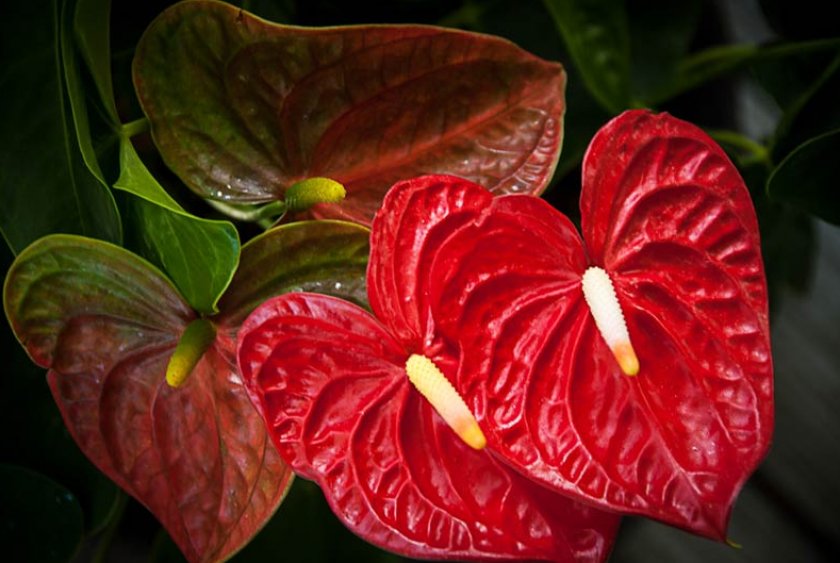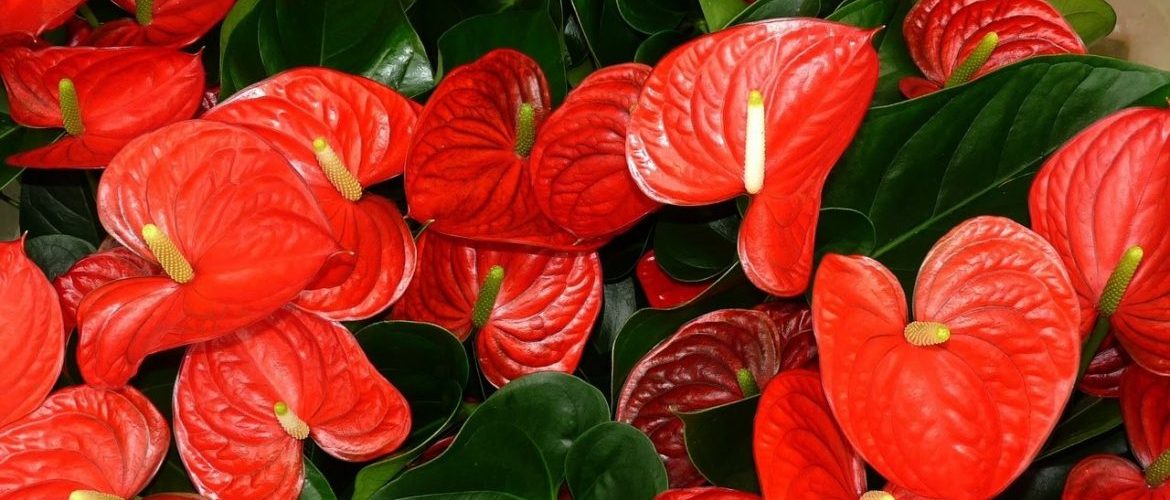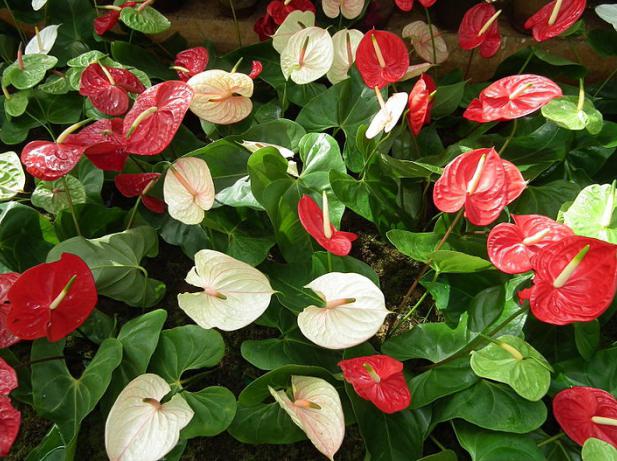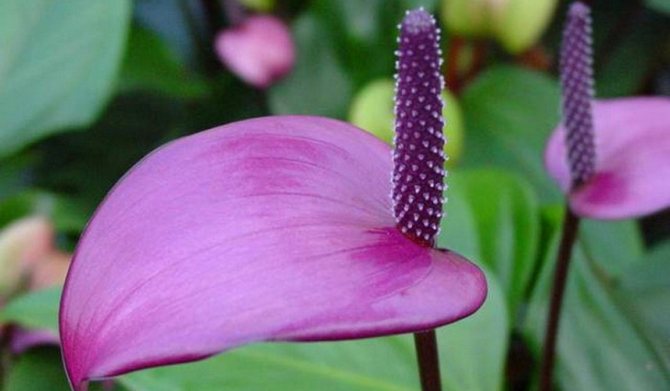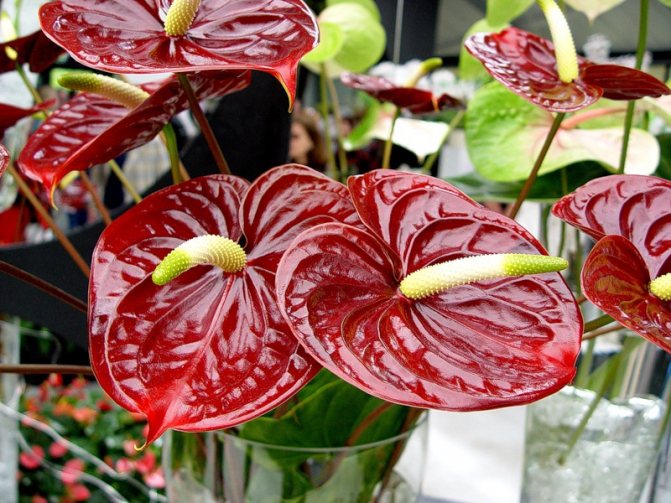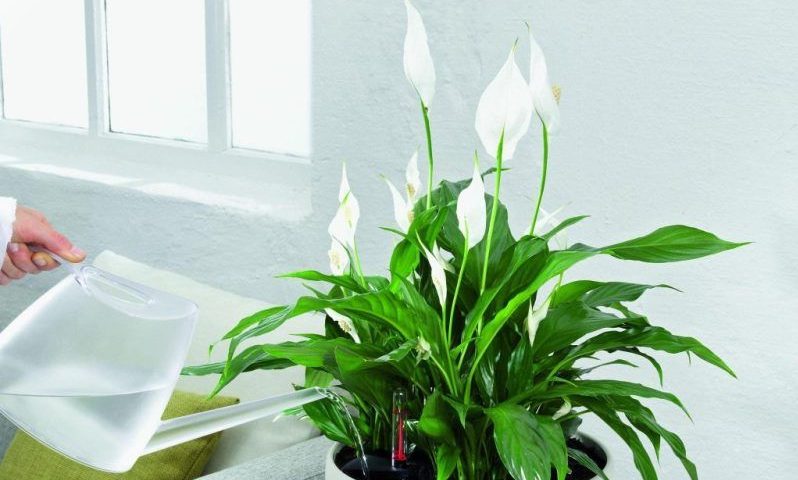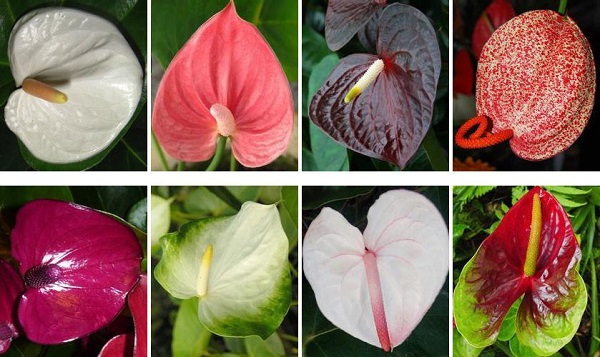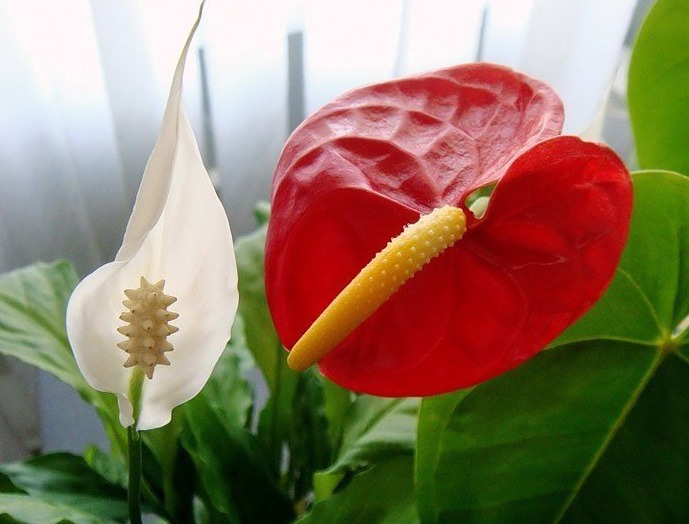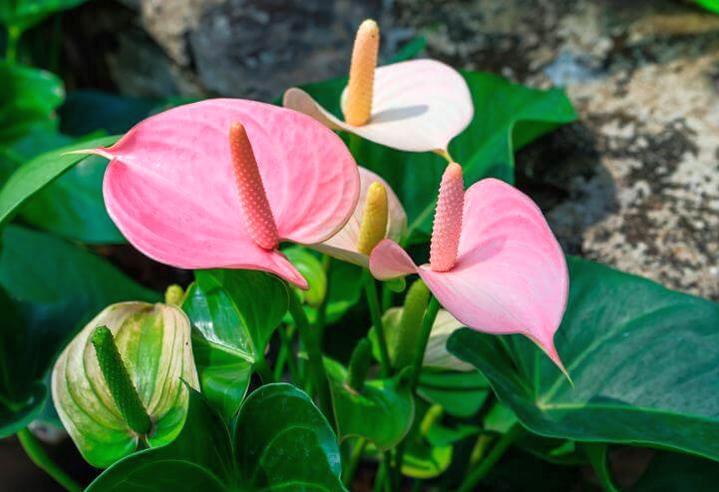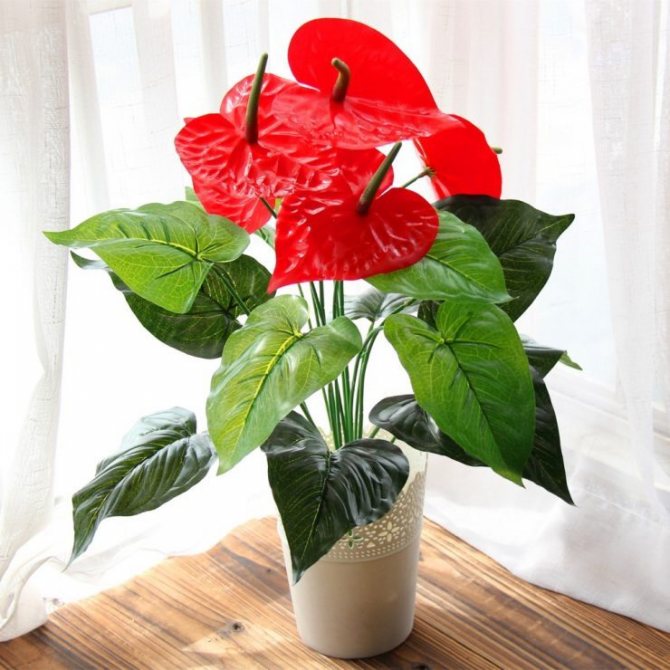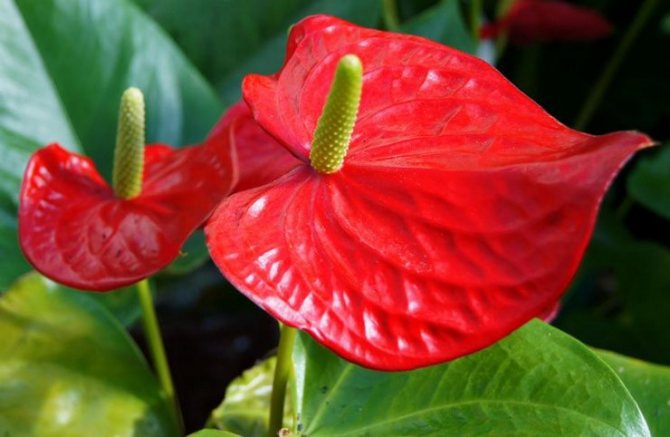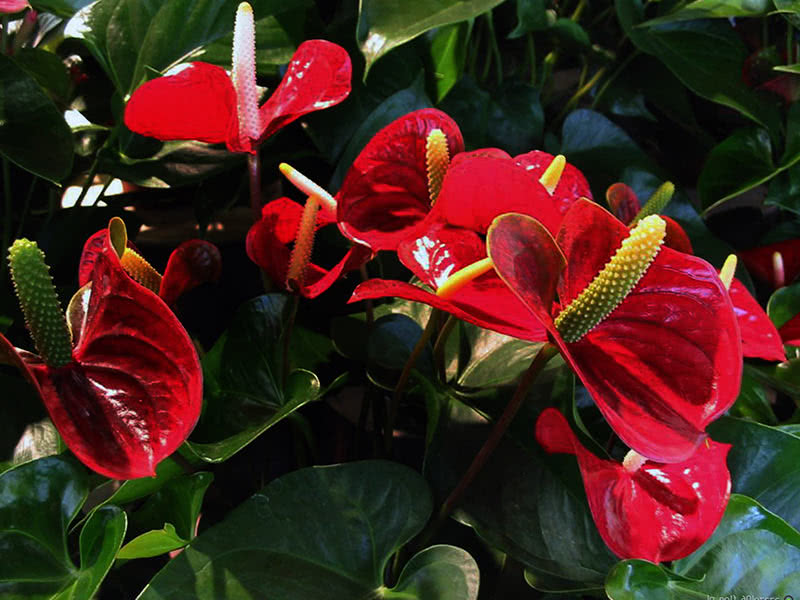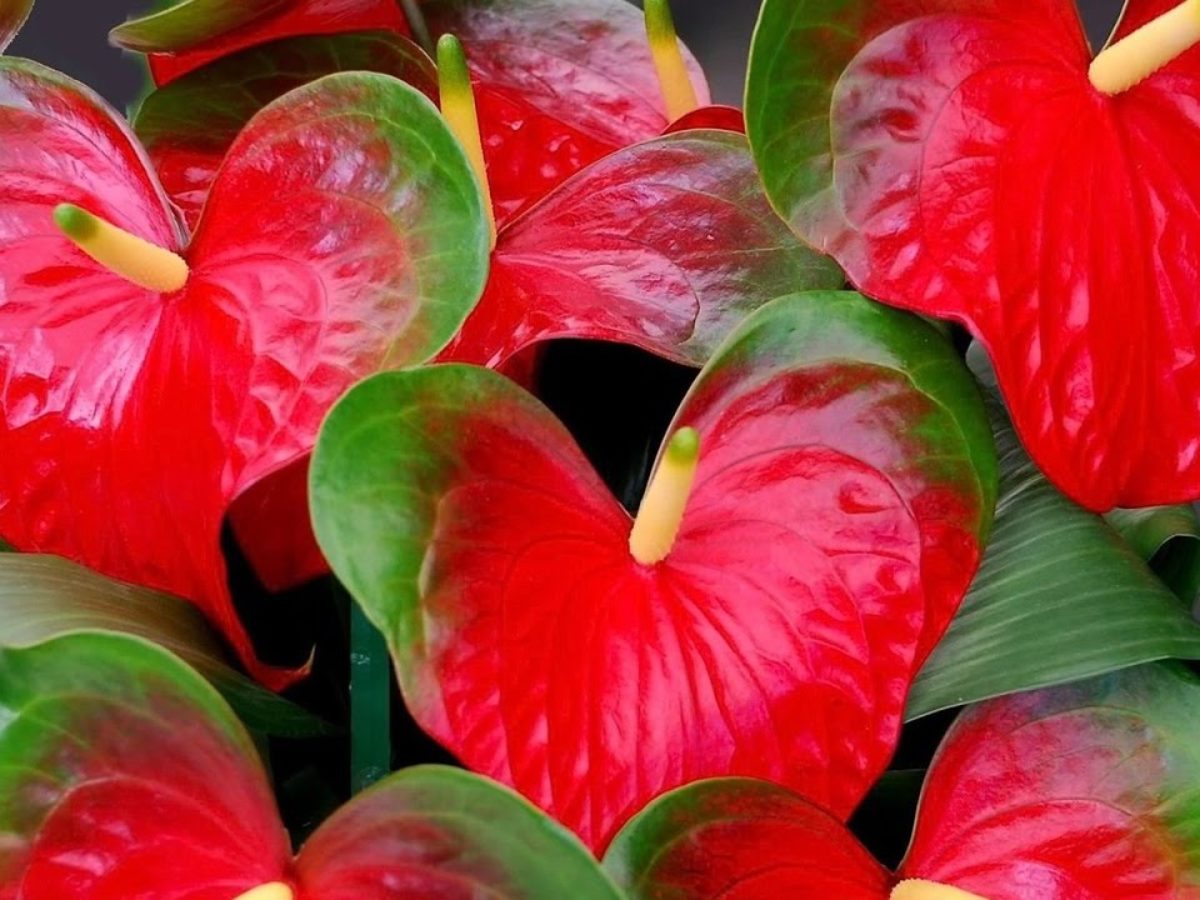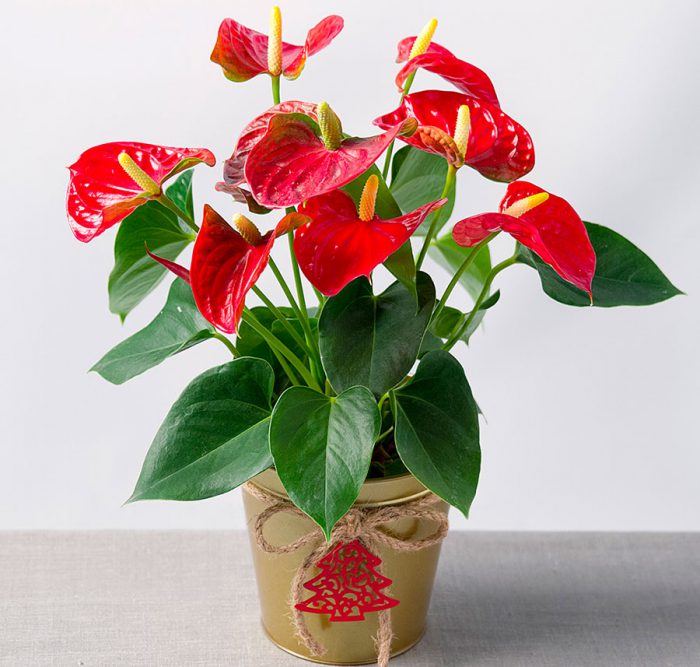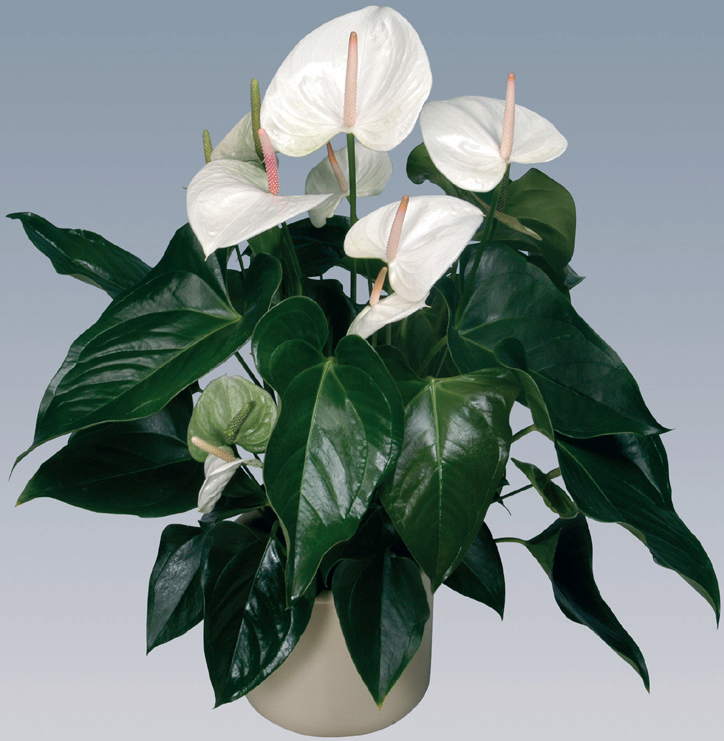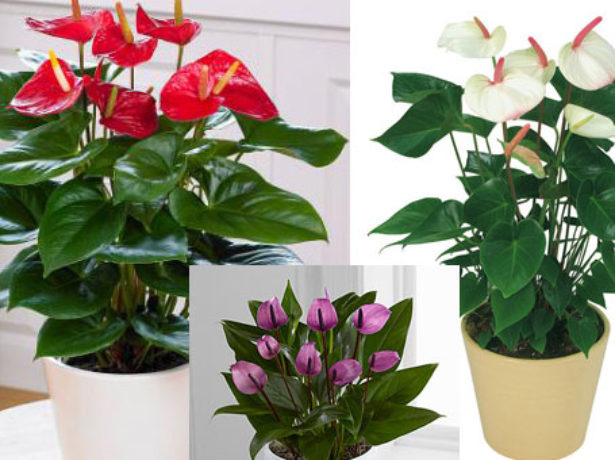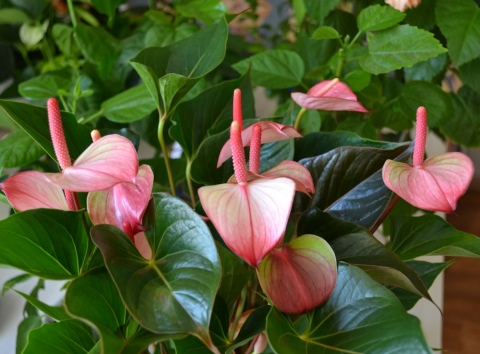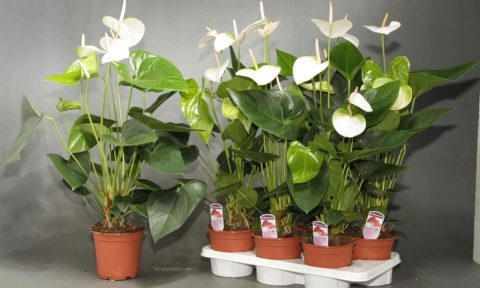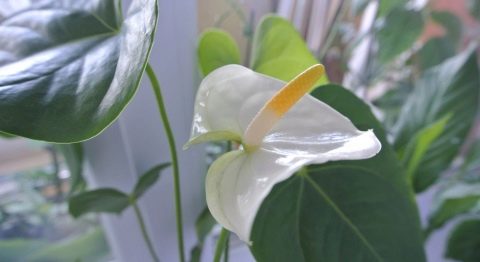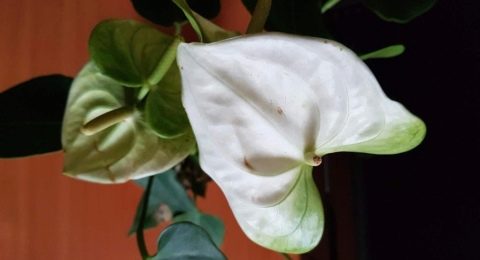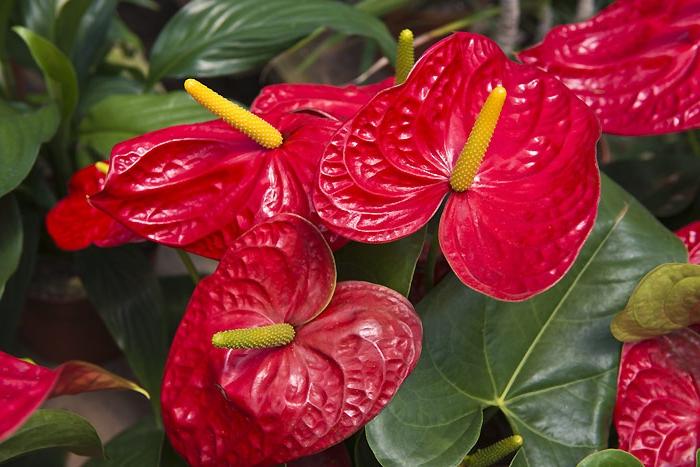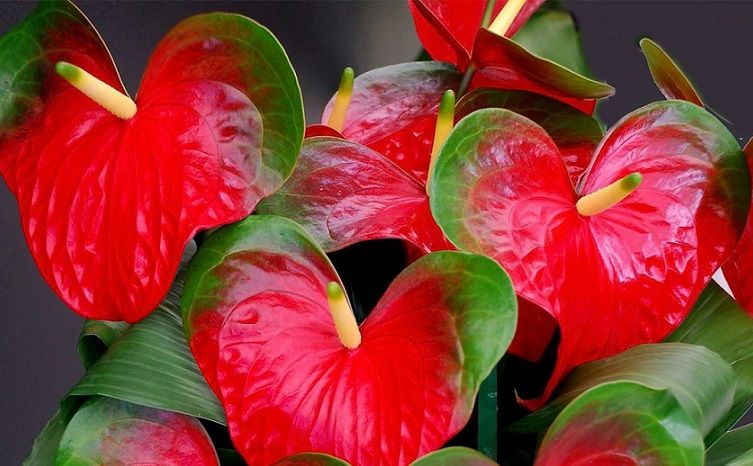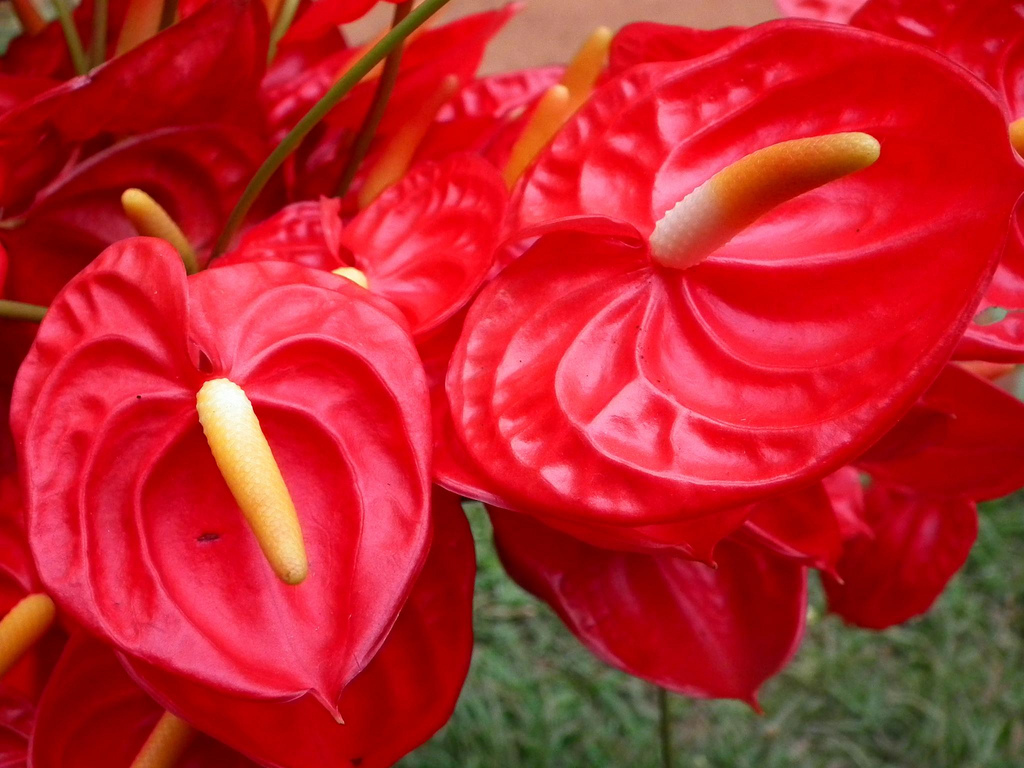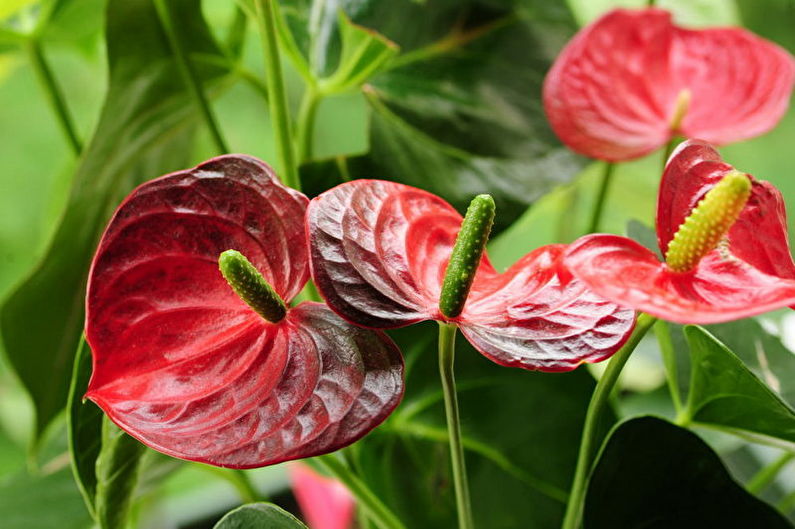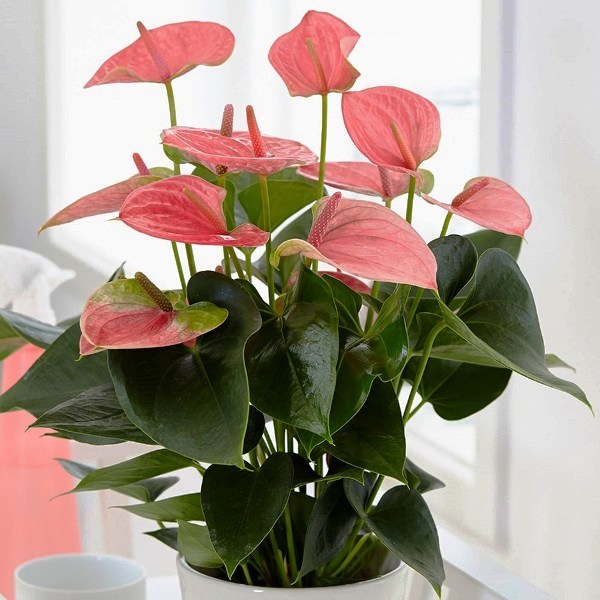Reproduction and transplantation of White Anthurium at home
Despite the fact that the flower is quite capricious, it is not at all difficult to propagate it. There are 4 types of flower reproduction at home:
- root shoots;
- lateral shoots;
- cuttings;
- seeds.
Even a beginner can cope with reproduction by root and side shoots. To do this, you just need to carefully separate the shoot from the mother bush and place it in greenhouse conditions. A mini greenhouse can be purchased or made on your own.
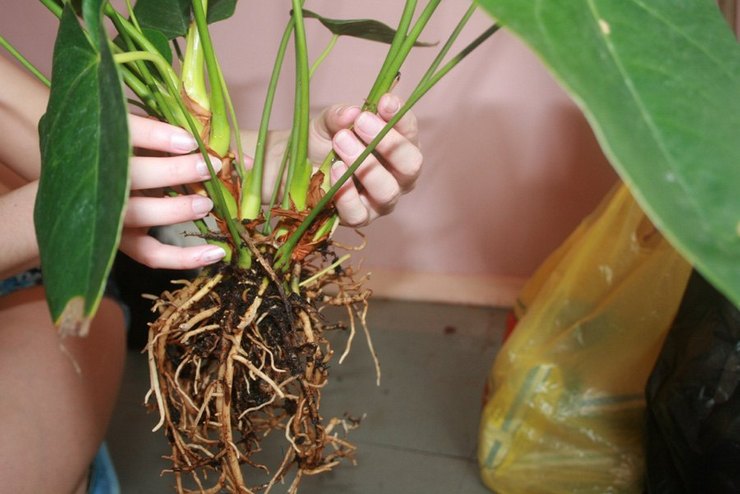
Anthurium transplant
All that is needed is a plastic container with a tight lid. Even a disposable glass will do if you fix cellophane on it with a pharmacy gum. At the bottom of the container, drainage holes are made - and the greenhouse is ready. The shoots are placed in soil saturated with sand, sprayed 2-3 times a day from a spray bottle.
Propagating Anthurium by grafting is also easy. To do this, cut off the leaf, capturing 3 cm of the petiole. So that the stalk does not lose moisture, the sheet is rolled up with a tube, weakly fixing it with a thread. Next, the clothespins are planted in a peat mixture or moss and covered with a glass jar. So the flower is kept for a month, sprinkled and ventilated daily, and then transplanted into a pot.
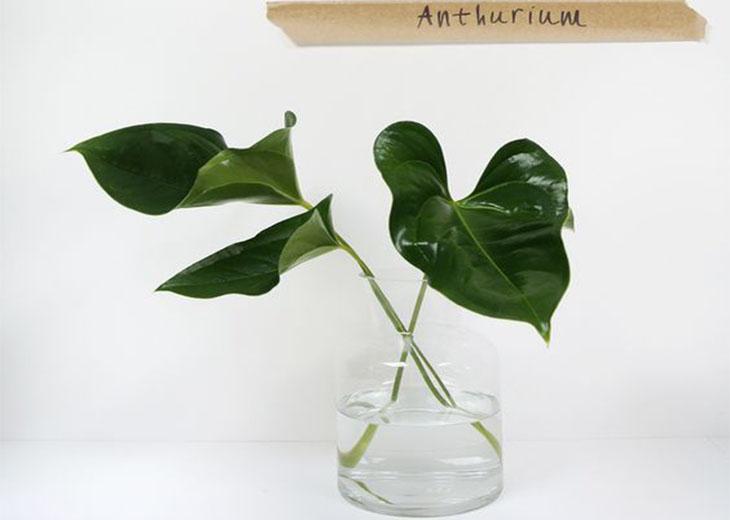
Cuttings
Seed propagation takes a long time. But this method provides an opportunity to breed a hybrid. Reproduction of Anthurium by seeds provides for the following stages:
- Plants do not pollinate on their own, so you need to transfer pollen from flower to flower using a cotton swab.
- The seeds ripen for about 9-12 months. A change in the color of the cob signals that the seeds are ready.
- Immediately after collection, the seeds should be soaked with a solution of any fungicide and sown.
- It is necessary to build a greenhouse over the sowing and spray the soil daily. Seedlings usually appear after a couple of weeks.
- As soon as the first leaf is formed on the sprout, it is planted in a separate pot, caring for it like a seedling from a mother bush.
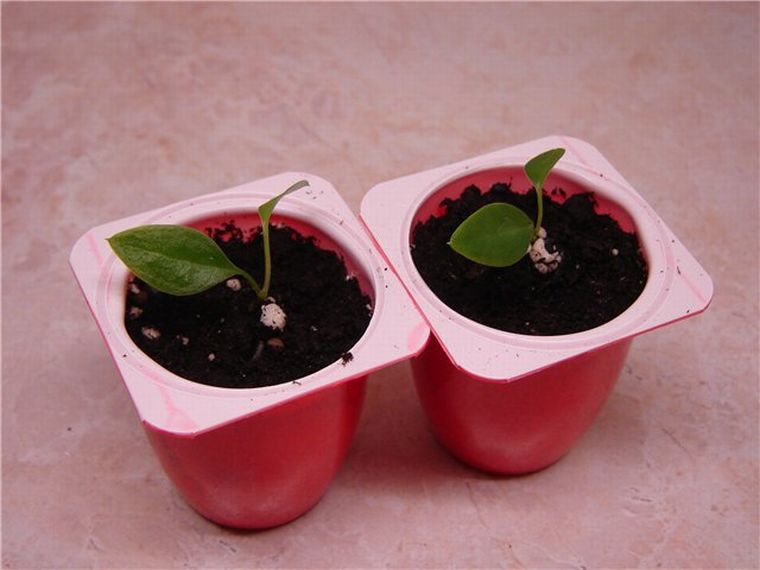
Reproduction of anthurium by seeds
If Anthurium multiplied by shoots is able to bloom in a year, then a flower derived from seeds will throw out its buds only after 2.5 years. Only by the age of 5 will he be able to bloom in large flowers. The ideal time for transplanting is considered the spring-summer period.
The plant is transplanted into a wide and not very deep pot; it is better to choose a plastic or glass option. For Anthurium, a soil consisting of peat, deciduous and coniferous humus (one part at a time), ½ part of sand with coniferous bark and charcoal is suitable
It is important to remove the plant carefully and after preliminary watering. If necessary, you need to remove the rotten roots, sprinkle the rhizome with phytolavine and put in a prepared pot, gradually adding the soil
It will also be interesting: Anthurium - reproduction and transplantation of a flower at home, male happiness?
Features of the reproduction of anthurium
"Male happiness" is propagated by vegetative methods and seeds. The latter method is not used by amateur flower growers, since such planting material loses its germination the very next day after collection. Therefore, reproduction of anthurium by dividing the bush (stem suckers) and apical cuttings is predominant.
Step-by-step instructions for propagation by cuttings
- Cut the top cuttings with two leaves, the length of the pieces should be 12-15 cm. Cut large leaf plates in half. Cut the lower part obliquely.
- Make a potting mix of equal proportions of peat and sand. Place the substrate in a shallow dish and moisten.
- Dip the lower cuts of anthurium cuttings into Kornevin or another root formation stimulator and plant them in the prepared soil at an angle, deepening about 5 cm.
- Keep the planting at a temperature of 24-25 degrees, moisten the soil daily and spray the cuttings.
- Planting material takes root very well under indoor conditions. Within a month, the cuttings will grow roots.
- Sit in a separate bowl and look after like adult anthuriums.
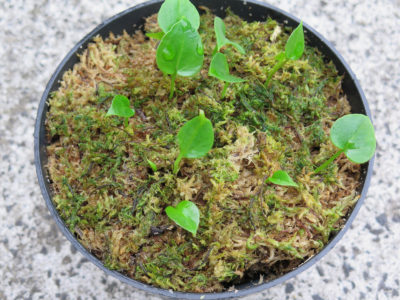
Apical cuttings of anthurium take root very quickly
Dividing a bush is the best way to reproduce
"Male happiness" quickly builds up lateral processes with its own roots. They can be used for flower propagation. Usually, the division procedure is carried out simultaneously with the transplant. For this:
Remove the mother plant from the soil, rinse the roots.
Separate the offspring carefully with a sharp, clean knife.
Sprinkle all sections with crushed activated carbon.
Plant the resulting cuttings in separate containers with drainage and special soil.
Moisten and place in a warm place.
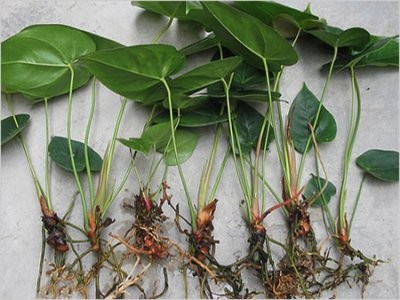
From one mother bush, you can get several divisions, from which new specimens of anthurium will grow
Reproduction
Indoor flower anthurium can multiply in several ways, but the most effective use of children and plant division. Reproduction takes place in the spring during disembarkation. The division is carried out with a sharp knife, and the sections are processed with crushed coal. After dividing, the plants are placed in different containers.
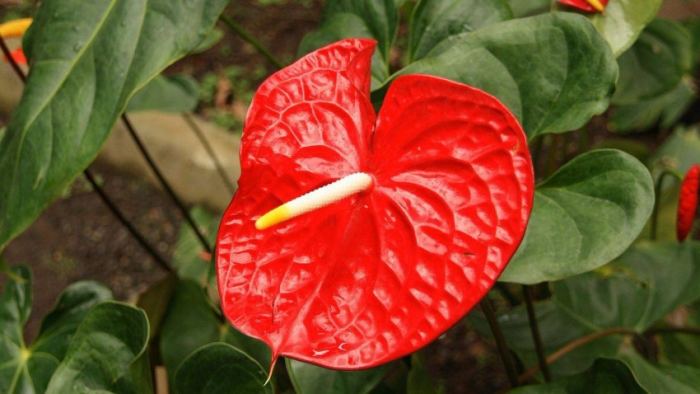

Seed propagation is also possible. However, in indoor conditions, not everyone can cope with the task. When flowering begins, Anthurium should be pollinated by holding a cotton swab over the cob. Cross-pollination is required for 2-3 days, repeating the procedure up to 3 times a day. After the appearance of the berries, they wait until they ripen - about 9-12 months.
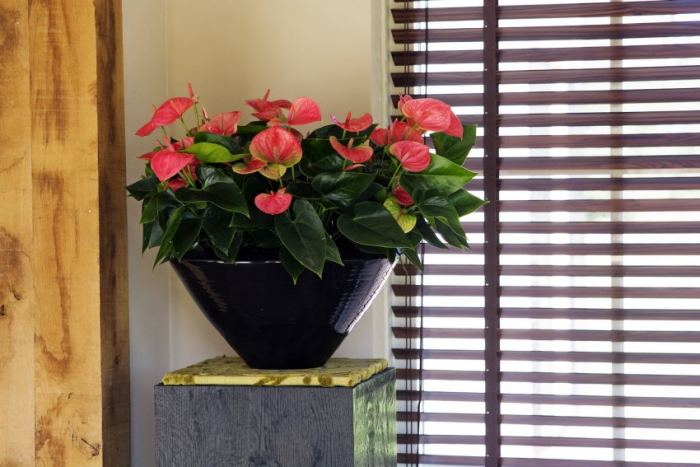
When propagating, you should take ripe seeds and peel them of pulp. Then they are planted in pots. Laid out on top of the soil, the seeds are slightly pressed and sprayed with water. The seedlings are transferred to the greenhouse and wait up to 2 weeks.
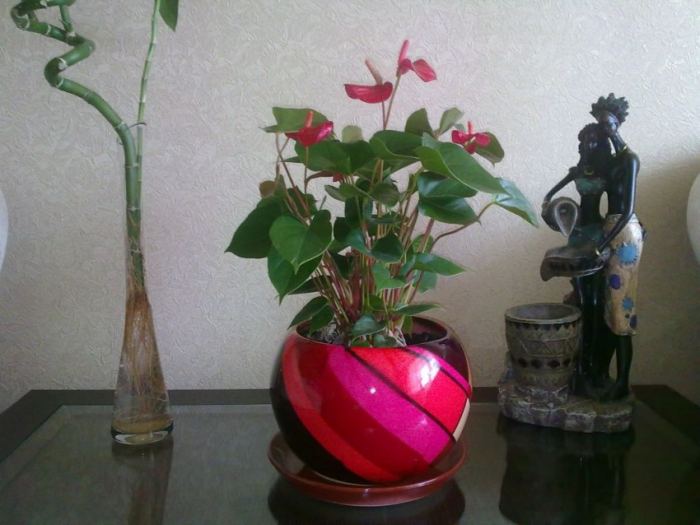
After the formation of the second leaflet, a dive is made, and after 2 months they do it again. When the seedlings have 5-6 leaves, they can be planted in pots. In the third year, flowering occurs, as can be seen in the photo of the anthurium.
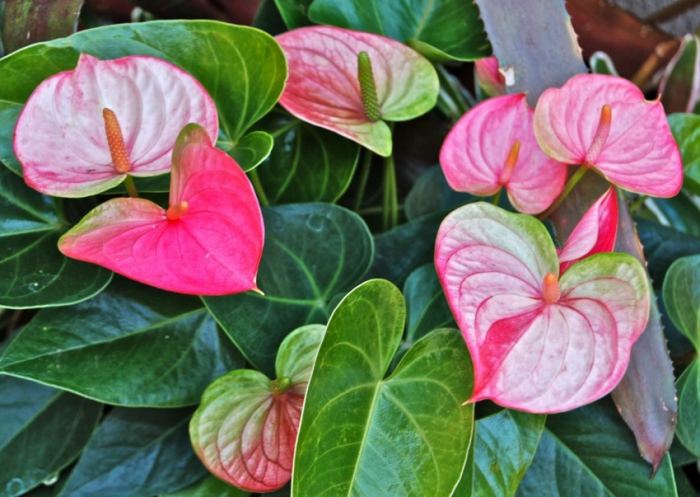
The nuances of care
Some growers claim that if you praise the anthurium, talk to it, then it grows and blooms better. However, conversations alone are not enough, this exotic handsome man also needs skillful care.
Lighting
Providing the anthurium with sufficient illumination is the easiest point in caring for it. Epiphytes grow in warm and sunny areas on trees. The rays of the bright sun penetrate to them through the crowns and scatter. It is these conditions that are familiar to anthurium, he loves partial shade and is afraid of direct sunlight. This flower does not need additional lighting even in winter. Therefore, in the spring and summer, keep the flower in the east or west window. You can take it to a sunny balcony or window, but put the anthurium pot in a shady corner. In the fall and throughout the winter, transfer to the south, southwest, or southeast window.
Video: what conditions need to be created for anthurium
Temperature and humidity
The room temperature suits Anthurium well, but the most favorable in summer: +28 ⁰C, and in winter it should not be colder than + 16 ... +18 ⁰C on the windowsill. The plant does not like drafts, but needs fresh air. On warm summer days, you can open the window by first removing the anthurium in a place protected from gusts of wind. With the onset of cold weather, place it only on a well-insulated window.
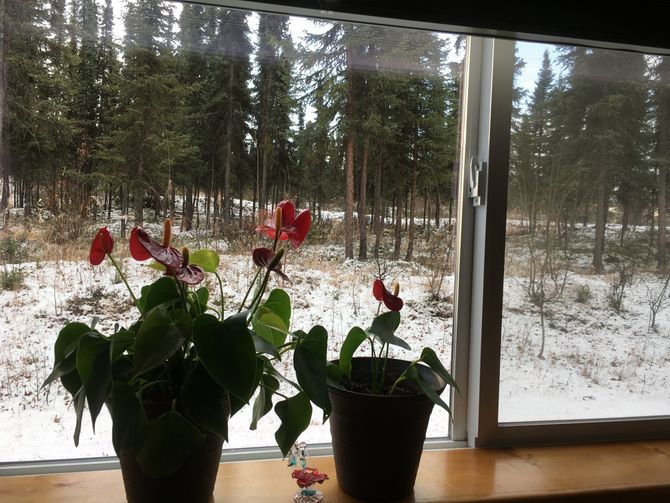
Do not put anthuriums close to glass, in summer the leaves will get burned, and in winter they will freeze
As for the humidity, then for a plant from tropical and subtropical forests, it should be increased.Room conditions in this parameter are far from natural: in winter, due to heating, the air is very dry, in rainy summer and autumn in apartments, on the contrary, it is damp. During periods when the heating is turned off, the humidity rises sharply, when connected, it also suddenly drops. Such drops affect the health of anthurium, leaves and flowers can turn yellow, turn black, become stained, dry out. Critical points should be kept in mind, especially when the air becomes dry, and try to keep it constantly moist.
Ways to increase humidity for anthurium:
- Spray the air around the flower. It is not recommended to get on the leaves and, especially on the sheet-cover, from drops on the surface, ugly spots remain.
- Place the pot on a tray of pebbles and moisten them constantly.
- Cover the potting soil with moss and keep it moist.
- Place the anthurium next to the aquarium, indoor fountain, dry linen next to it, or put a small rug on the radiator and moisten it.
Once a week, wipe the anthurium leaves from dust with a damp soft sponge or arrange a warm shower (+30 ⁰C), after covering the ground with a film.
Watering rules
Water the anthurium only with settled water at room temperature. Epiphytes need moisture in the air, but they suffer greatly from soil overflow, rot and die. Watering is necessary when the soil in the pot dries up, and even the leaves wilt a little. Soak the entire clod of earth and immediately drain the water from the sump. If the room is damp, there is an aquarium or other source of moisture, the soil can remain moist for weeks, since the anthurium has enough water taken from the air. When the air is dry, you will have to water more often and take care of the increase in humidity.
Video: signs of anthurium overflow
Top dressing and fertilizers
Fertilizers created specifically for anthurium are still scarce on sale. If you manage to find one, use it. Otherwise, any universal for flowering indoor plants will do. They are sold under the brands: Clean Sheet, Agricola, AVA, Bona Forte, etc. Be sure to follow the dosage, it is better to underfeed than overfeed. An excess of salts in the soil can lead to root burns and the death of the entire plant.

Never dilute fertilizers "by eye", use measuring containers
You need to feed anthurium once every 1-2 weeks. The frequency depends on its condition. If the plant looks healthy: the leaves and flowers have a color corresponding to the variety, develop well, young leaves and buds appear actively, you need to feed less often. In autumn and winter, you can completely abandon fertilizers or give them once a month in half the dose.
Flower diseases
1. If the tips of the leaves are on Anthurium darkened, it means that an excessive amount of lime predominates in the soil.
2. The appeared black dots on the flower indicate that the plant is experiencing a lack of heat for a long time. If the plant is not warmed up in time, it will certainly undergo wilting.
3. If the leaves on the plant turn yellow, then it is experiencing a moisture deficit or the plant was attacked by orange aphids, which are removed with a solution of pyrethrum, actellic and karbofos.
4. Cracked leaves and dark spots are indicative of a mealy worm. A drug such as karbofos will help get rid of it.
5. Gray bloom and yellow leaves on the plant indicate that there is stagnant moisture in the soil. Topsin will save the plant from this misfortune.
6. If a sticky bloom has appeared on the flower, this indicates the appearance of a scale insect on it. The plant must be treated with soapy water.
If the care of the tropical handsome man is carried out correctly, it will prevent the flower from many of the listed diseases, and the timely treatment will protect the plant from its death.
Home anthurium - description
Among anthuriums there are epiphytes with aerial roots growing on trees, there are semi-epiphytes, there are lithophytes growing on stones, and there are also terrestrial plants.Some anthuriums even enter into symbiosis with colonies of worker ants. At home, representatives of the genus grow up to 70 cm.

Anthurium leaves can be spatulate, arrow-shaped, heart-shaped, rounded and even dissected, with a glossy or matte surface. In rainforests, anthurium leaves turn in the wake of the sun. However, the anthurium plant is interesting primarily for its flowers: cone-shaped, clavate, spherical or spiral cobs wrapped in a sail, or a veil, that is, a bracts of white, red, burgundy or purple. There are even varieties with multi-colored and black bracts. And the ear is an inflorescence, consisting of flowers tightly pressed against each other. Moreover, in each species, the flowers have a special smell - weak or strong, sometimes pleasant, and sometimes fetid. Anthurium at home with sufficient lighting can bloom all year round, with each flower living up to one and a half months. And artificially dusting indoor anthurium, you can get fruits - orange or red berries with two seeds.

